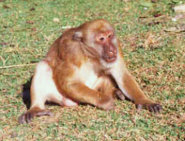 The Assam Macaque (Macaca assamensis) is a species of primate that lives in Southeast Asia, and can be found in India, Vietnam, Nepal, Thailand, and southern China. It is an omnivorous animal that feeds on both vegetation, and on meat - being the meat of insects and other invertebrates. They are like most macaques in appearance; however coloration is that of medium amber with a lighter belly and underside, while their skin is a reddish dark tan. They have been recently seen in some areas as a declining population, however numbers are still high. Unfortunately the Assam Macaque is listed as near-threatened due to hunting and poaching and they are estimated to have just 300 left in Nepal.
The Assam Macaque (Macaca assamensis) is a species of primate that lives in Southeast Asia, and can be found in India, Vietnam, Nepal, Thailand, and southern China. It is an omnivorous animal that feeds on both vegetation, and on meat - being the meat of insects and other invertebrates. They are like most macaques in appearance; however coloration is that of medium amber with a lighter belly and underside, while their skin is a reddish dark tan. They have been recently seen in some areas as a declining population, however numbers are still high. Unfortunately the Assam Macaque is listed as near-threatened due to hunting and poaching and they are estimated to have just 300 left in Nepal. Their behavior consists of foraging and social interaction along with grooming and sleeping. As a diurnal animal, they are much like us in that during the day they are active, doing what they do, and at night they sleep. They will live either in trees (which is called arboreal) or on the ground (which is called terrestrial), however it obviously has a preference for the denser areas and is subsequently most frequent in dense forests.
There are two subspecies of the Assam Macaque:
The Eastern Assamese Macaque (Macca assamensis assamensis) is located around Bhutan, southern China, northeastern India, Lao, Myanmar, Thailand, and Vietnam.
The Western Assamese Macaque (Macca assamensis pelops) is only found in a few populations that are next to each other in India, Bhutan, and also China. There are less than 1,000 left alive in the wild and they are at a high risk of becoming extinct.
Both subspecies belong to the species Macca assamensis, and the Assam Macaque belongs to the Genus Macca. Macca contains many different species of macaques including some extinct fossil species. This genus belongs to the Subfamily Cercopithecinae, which has twelve genera of living species such as Allen's Swamp Monkey, Patas Monkey, guenons, mangabeys, and possibly more. This Subfamily belongs to the Family Cercopithecidae which belongs to the Superfamily Cercopithecoidea, which are called Old World Monkeys, members include Colobus, Langurs, Surilis, and Doucs (along with too many more to list) are members. This Superfamily belongs to the Parvorder Catarrhini, and there’s something very special about this Parvorder. We’re a member of Catarrhini, as the three families in it are Cercopithecidae, Hylobatidae, and Hominidae (that’s ours). In addition to having all of the Old World Monkeys, and the gibbons, it also includes the Great Apes, such as Gorillas, Orangutans, Chimps, and Humans (Homo sapiens sapiens). Catarrhini belongs to the Infraorder Simiiformes. Simiiformes belongs to the Suborder Haplorrhini which includes all that has been listed along with the extinct omomyids. Haplorrhini belongs to the Order Primates which has one other Suborder, Strepsirrhini, so in addition to what has been listed, this includes the non-tarsier prosimians such as lemurs. This leads to the Class Mammalia in the following way: Order Primates -> Superorder Euarchontoglires (includes rabbits and rats) -> Infraclass Eutheria (placentals) -> Subclass Theria (all but monotremes) -> Mammalia (all mammals).
The Western Assamese Macaque may be extinct within the next 50 years without proper management and habitat restoration.
The Assam macaque, assamese macaque is listed as Vulnerable (VU), considered to be facing a high risk of extinction in the wild, on the IUCN Red List of Threatened Species

Custom Search